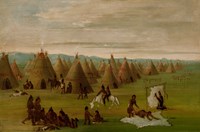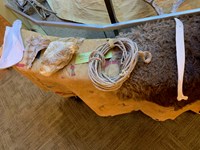- Lesson Plan (235)
- Field Trips (66)
- Distance Learning (43)
- Student Activities (26)
- Guest Speakers (18)
- Teacher Reference Materials (11)
- Traveling Trunk (11)
- Primary Sources (10)
- Media for Loan (4)
- Other Education Materials (4)
- Science Labs (2)
- Field Schools & Institutes (1)
- Online Galleries (1)
- Cowpens National Battlefield (24)
- Andersonville National Historic Site (20)
- Fort Scott National Historic Site (15)
- Fort Necessity National Battlefield (14)
- Kennesaw Mountain National Battlefield Park (14)
- Bent's Old Fort National Historic Site (12)
- Palo Alto Battlefield National Historical Park (12)
- Charles Young Buffalo Soldiers National Monument (11)
- Gettysburg National Military Park (11)
- Show More ...
- Social Studies (373)
- Literacy and Language Arts (129)
- Science (71)
- Math (24)
Showing 423 results for Plains War ...
Provider of the Plains - Bison
Plains Indians Traveling Trunk
- Type: Traveling Trunk
- Grade Levels: Upper Elementary: Third Grade through Fifth Grade
American Indians and the Great Plains
- Type: Field Trips
- Grade Levels: Lower Elementary: Pre-Kindergarten through Second Grade

American Indians have lived in North America for thousands of years. All of the lands that make up the United States today were exclusively Indigenous lands long before Europeans first arrived about 500 years ago. The growth of the United States through westward expansion challenged traditional ways of life for many Indigenous tribes during the 1800s as more settlers crossed the Mississippi River for a new life in the West.
Plains Indians Scout Program
Flora on the Plains: Grasses, Trees, and Agriculture
- Type: Lesson Plan
- Grade Levels: Upper Elementary: Third Grade through Fifth Grade
Optical Illusions and Mirage on the Great Plains
- Type: Lesson Plan
- Grade Levels: Upper Elementary: Third Grade through Fifth Grade
Are your eyes playing tricks on you or is it the light? This lesson explores the properties of light and the environmental conditions which cause mirages. Students will examine some famous optical illusions before reading Josiah Gregg's experience with them when traveling across the Great Plains in the 1830s and 1840s.
Geography: Navigation and Isolation on the Great Plains
- Type: Lesson Plan
- Grade Levels: Upper Elementary: Third Grade through Fifth Grade
Getting lost in unfamiliar surroundings is a common human experience. In this lesson students will take on the role of navigator and mapmaker to pinpoint a location. By doing so, students will recognize that migration across the Great Plains landscape in the 1830s and 1840s required a unique set of survival skills and navigational tools.
Playing the Past
- Type: Field Trips
- Grade Levels: Upper Elementary: Third Grade through Fifth Grade
- Type: Lesson Plan
- Grade Levels: Middle School: Sixth Grade through Eighth Grade
American Indians and the Great Plains (Distance Learning)
- Type: Distance Learning
- Grade Levels: Lower Elementary: Pre-Kindergarten through Second Grade

In this distance learning program, students will compare and contrast their lives with that of traditional Plains Indian tribes during the 1800s. They will learn how tribes such as the Dakota, Lakota, Osage, and others used nature and the lands around them to shape traditional tribal customs, and discuss how westward expansion changed their way of life.
Black Homesteaders on the Great Plains: Life Liberty and the Pursuit of Happiness (Adult)
Grade 3-8 Harriet Tubman, Brave Woman or Just Plain Crazy?
- Type: Lesson Plan
- Grade Levels: Upper Elementary: Third Grade through Fifth Grade

To better understand Harriet Tubman's decisions in the larger context of the institution of slavery. What led Tubman to escape slavery and to return to rescue her family and friends? What factors led other enslaved people to remain in their conditions? Was Harriet Tubman's decision a product of personal courage, her situation as an enslaved woman facing sale, or a grave risk?
Black Homesteaders on the Great Plains: Life Liberty and the Pursuit of Happiness (9th - 12th)
- Type: Distance Learning
- Grade Levels: High School: Ninth Grade through Twelfth Grade

The call of free land offered Black Americans a welcome reprieve from a cycle of poverty driven by sharecropping and racialized violence in the South. The Homestead Act of 1862 helped at least 3400 Black farmers build homes across the Great Plains. Homesteading attracted groundbreaking independent Black filmmaker Oscar Micheaux and agronomist and inventor George Washington Carver.
Black Homesteaders on the Great Plains: Life Liberty and the Pursuit of Happiness (6th - 8th)
- Type: Distance Learning
- Grade Levels: Middle School: Sixth Grade through Eighth Grade

The call of free land offered Black Americans a welcome reprieve from a cycle of poverty driven by sharecropping and racialized violence in the South. The Homestead Act of 1862 helped at least 3400 Black farmers build homes across the Great Plains. Homesteading attracted groundbreaking independent Black filmmaker Oscar Micheaux and agronomist and inventor George Washington Carver.
Perform Your Own Play-doh Crawfish Dissection
- Type: Student Activities
- Grade Levels: Middle School: Sixth Grade through Eighth Grade

Dissect a play-doh crawfish with Dr. Liz! Crawfish are more than just arthropods, they are an iconic species and food source in Southeastern Louisiana. We know “pinch the tail” and “suck the head”, but there is more to crawfish than just a boil! In this activity, you will create your own crawfish with clay or play-doh and follow along with Dr. Liz!
Weapons of the Revolutionary War
Women in the Civil War
Influence of War Post-Activity 2: Influence of War on Copper Industry
War on the Home Front: Civil War Reading Passage with Graphic Organizer
- Type: Lesson Plan
- Grade Levels: Upper Elementary: Third Grade through Fifth Grade
The Civil War and its outcomes were life-changing events for all the people, both free and enslaved, who were associated with the Burroughs Plantation from 1850 – 1865. Students will learn about: •Life on a piedmont Virginia, slaveholding tobacco farm •National debate on slavery/Differences between North and South •Why the war was fought •How the enslaved and their owners reacted to the war •How each group was affected after the war










